Surface Bubbles Emergence as an Indicator for Optimal Concrete Compaction
Abstract
:1. Introduction
2. Materials and Methods
2.1. Materials and Mix Design
2.2. Methods
2.2.1. Concrete Mixing, Standard Testing, and Casting
2.2.2. Compaction and Surface Video Recording
2.2.3. Frames Extraction and Bubbles Selection
2.2.4. Sawing and Density Measurements
3. Results and Analysis
3.1. Fresh Concrete Properties
3.2. Surface Bubbles Analysis
3.2.1. Initial Processing of Bubbles Data
3.2.2. Newly Risen Bubbles per Frame
3.2.3. Patterns of Bubbles Rising Behavior
3.3. Segregation Analysis
4. Discussion
5. Conclusions
- None of the six tested specimens exhibited a total cessation of bubble emergence, indicating the need for prolonged compaction. However, all the specimens exhibited various levels of segregation, with some more pronounced than others.
- Half of the specimens demonstrated continuous bubble emergence without any signs of slowing.
- The remaining three specimens showed a decrease in bubble emergence rates, yet none approached a cessation, with the lowest rates recorded at 1.6 and 2.5 bubbles/s.
- Despite being cast from the same batch and compacted by the same compaction table, the specimens displayed differing bubble emergence profiles.
Author Contributions
Funding
Institutional Review Board Statement
Informed Consent Statement
Data Availability Statement
Conflicts of Interest
References
- Ojala, T.; Ahmed, H.; Kuusela, P.; Seppänen, A.; Punkki, J. Monitoring of concrete segregation using AC impedance spectroscopy. Constr. Build. Mater. 2023, 384, 131453. [Google Scholar] [CrossRef]
- Quan, Y.; Wang, F. Machine learning-based real-time tracking for concrete vibration. Autom. Constr. 2022, 140, 104343. [Google Scholar] [CrossRef]
- Tian, Z.; Sun, X.; Su, W.; Li, D.; Yang, B.; Bian, C.; Wu, J. Development of real-time visual monitoring system for vibration effects on fresh concrete. Autom. Constr. 2019, 98, 61–71. [Google Scholar] [CrossRef]
- Gong, J.; Yu, Y.; Krishnamoorthy, R.; Roda, A. Real-time tracking of concrete vibration effort for intelligent concrete consolidation. Autom. Constr. 2015, 54, 12–24. [Google Scholar] [CrossRef]
- Valente Monteiro, A.; Gonçalves, A.; Balayssac, J.P.; Yssorche-Cubaynes, M.P.; Costa, A. On the role of compaction in disputes over the quality of the supplied concrete. Mater. Struct. 2023, 56, 60. [Google Scholar] [CrossRef]
- Cement Concrete and Aggregates Australia. Compaction of Concrete. 2006. Available online: https://www.yumpu.com/en/document/view/3646532/compaction-of-concrete-cement-concrete-aggregates-australia (accessed on 20 April 2024).
- American Concrete Institute. Guide for Consolidation of Concrete. 2005. Available online: https://www.concrete.org/store/productdetail.aspx?ItemID=30905&Language=English&Units=US_AND_METRIC (accessed on 10 February 2023).
- Neville, A.M. Properties of Concrete, 5th ed.; Pearson: Harlow, UK; New York, NY, USA, 2011. [Google Scholar]
- ASTM C457/C457M—16; Standard Test Method for Microscopical Determination of Parameters of the Air-Void System in Hardened Concrete 2016. ASTM: West Conshohocken, PA, USA, 2023. [CrossRef]
- Mehta, P.K.; Monteiro, P.J.M. Concrete Microstructure, Properties, and Materials, 3rd ed.; McGraw-Hill Professional Publishing: Columbus, OH, USA, 2005. [Google Scholar]
- Suomen Betoniyhdistys ry, Betonin Laadunvarmistus. Osa 1-Betonin Ilmahuokosparametrien Määritys Ohuthieistä, [Determination of Concrete Air Pore Parameters from Thin Sections] Suomen Betoniyhdistys ry. 2020. Available online: www.betoniyhdistys.fi (accessed on 10 January 2024). (In Finnish).
- Kisaku, T.; Yoshida, Y.; Muto, K.; Kurosawa, T.; Ito, Y.; Fujiyama, C. Prediction of effective vibration condition under air void reduction using mortar rheological constant. Eng. Rep. 2022, 4, e12484. [Google Scholar] [CrossRef]
- Gao, X.; Zhang, J.; Su, Y. Influence of vibration-induced segregation on mechanical property and chloride ion permeability of concrete with variable rheological performance. Constr. Build. Mater. 2019, 194, 32–41. [Google Scholar] [CrossRef]
- Ahmed, H.; Kuva, J.; Punkki, J. Analysing entrapped pores in concrete via x-ray computed tomography: Influence of workability and compaction time. Constr. Build. Mater. 2024, 417, 135322. [Google Scholar] [CrossRef]
- EN 12390-2; Testing Hardened Concrete. Part 2: Making and Curing Specimens for Strength Tests. Finnish Standards Association: Helsinki, Finland, 2019.
- EN-13670-1:2000; Execution of Concrete Structures—Part 1: Common. British Standards Institution: London, UK, 2000.
- Wang, D.; Ren, B.; Cui, B.; Wang, J.; Wang, X.; Guan, T. Real-time monitoring for vibration quality of fresh concrete using convolutional neural networks and IoT technology. Autom. Constr. 2021, 123, 103510. [Google Scholar] [CrossRef]
- Li, J.; Tian, Z.; Sun, X.; Ma, Y.; Liu, H.; Lu, H. Modeling vibration energy transfer of fresh concrete and energy distribution visualization system. Constr. Build. Mater. 2022, 354, 129210. [Google Scholar] [CrossRef]
- Li, J.; Tian, Z.; Yu, X.; Xiang, J.; Fan, H. Vibration quality evaluation of reinforced concrete using energy transfer model. Constr. Build. Mater. 2023, 379, 131247. [Google Scholar] [CrossRef]
- Tian, Z.; Bian, C. Visual monitoring method on fresh concrete vibration. KSCE J. Civ. Eng. 2014, 18, 398–408. [Google Scholar] [CrossRef]
- Ren, B.; Wang, H.; Wang, D.; Guan, T.; Zheng, X. Vision method based on deep learning for detecting concrete vibration quality. Case Stud. Constr. Mater. 2023, 18, e02132. [Google Scholar] [CrossRef]
- Ahmed, H.; Punkki, J. Methods for Assessing Concrete Segregation Due to Compaction. Nord. Concr. Res. 2024, 70, 1–23. [Google Scholar]
- SFS-EN 12350-2:2019; Testing of Fresh Concrete. Part 2: Depression. SFS: Helsinki, Finland, 2019.
- SFS-EN 12350-7:2019; Testing Fresh Concrete. Part 7: Air Content. Pressure Methods. SFS: Helsinki, Finland, 2019.
- Haas, T.; Schubert, C.; Eickhoff, M.; Pfeifer, H. BubCNN: Bubble detection using Faster RCNN and shape regression network. Chem. Eng. Sci. 2020, 216, 115467. [Google Scholar] [CrossRef]
- EN 12390-7:2019; Testing Hardened Concrete—Part 7: Density of Hardened Concrete. SFS: Helsinki, Finland, 2019.
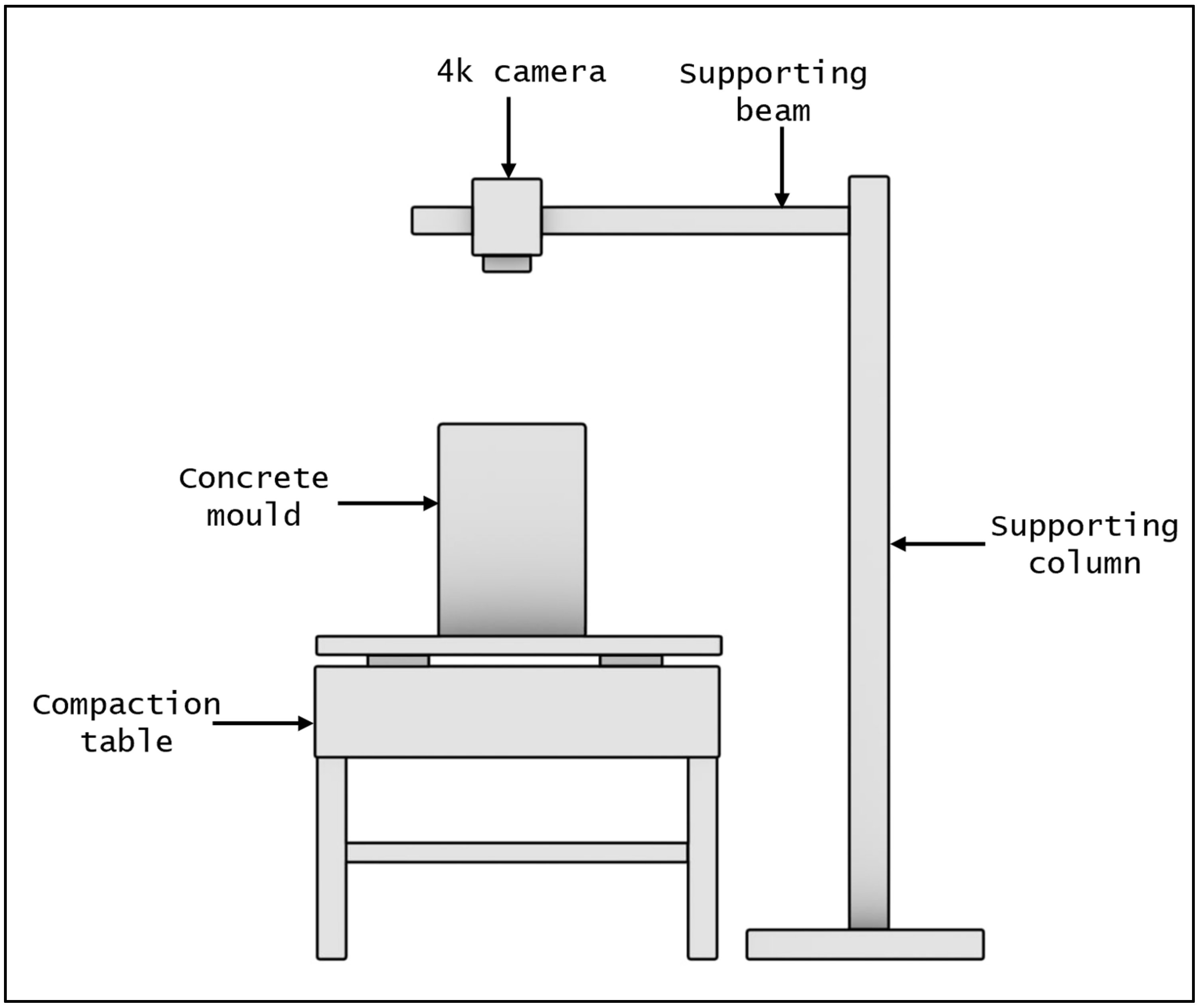
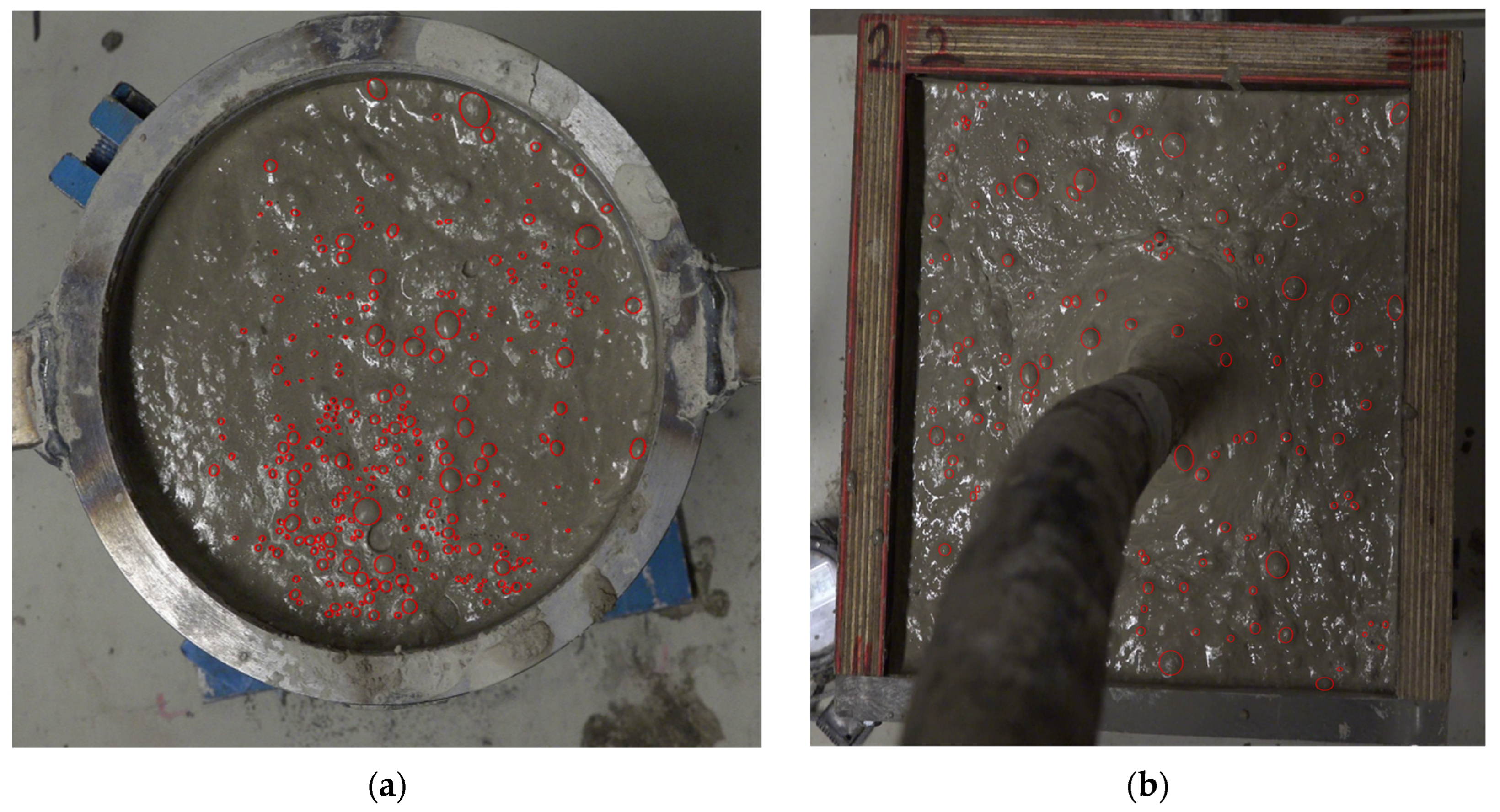
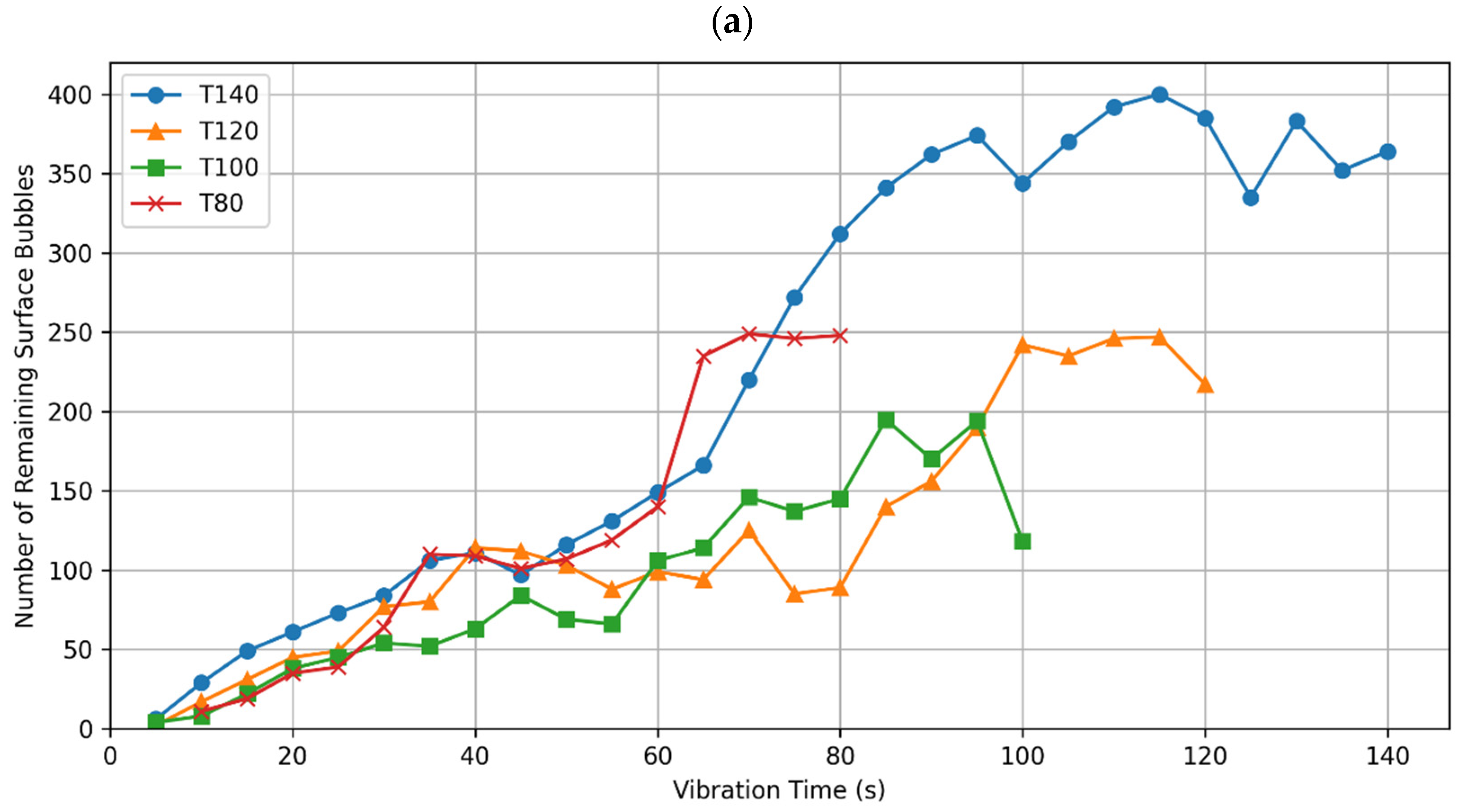
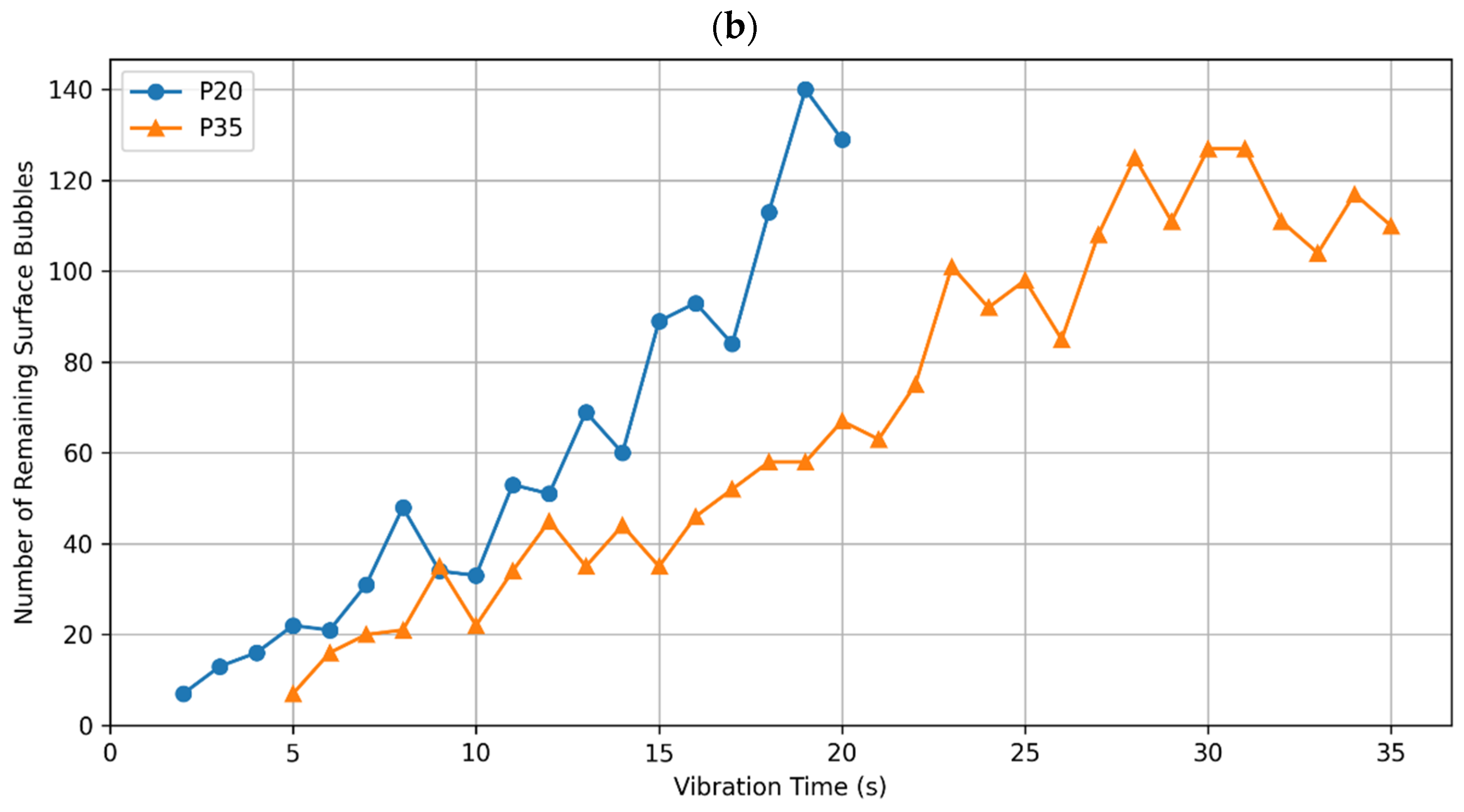

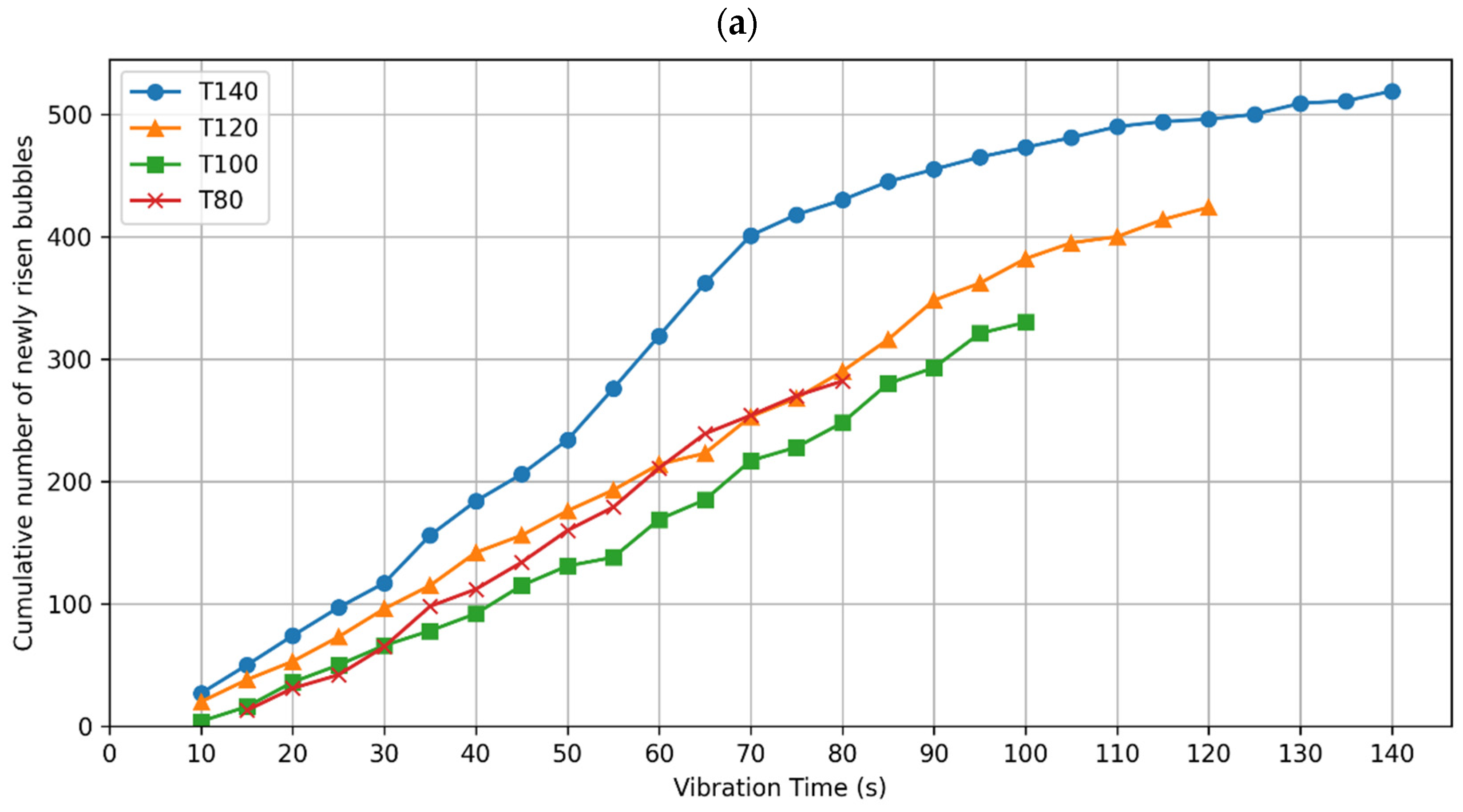


| Chemical Composition | Mass Percentage Volume (%) |
|---|---|
| CaO | 64–66 |
| SiO2 | 20–22 |
| Al2O3 | 4.0–5.4 |
| Fe2O3 | 2.8–3.2 |
| MgO | 2.5–3.2 |
| SO3 | 3.0–3.3 |
| Aggregate Type | Fraction (Diameter in mm) | Weight Proportion (%) | Sieve Size (mm) | |||||||||
|---|---|---|---|---|---|---|---|---|---|---|---|---|
| 0.125 | 0.25 | 0.5 | 1.0 | 2.0 | 4.0 | 8.0 | 16.0 | 32.0 | 64.0 | |||
| Filler | <1 | 8 | 42 | 81 | 93 | 97 | 98 | 100 | 100 | 100 | 100 | 100 |
| Fine Aggregates (FA) | 0.1–0.6 | 12 | 3 | 21 | 76 | 100 | 100 | 100 | 100 | 100 | 100 | 100 |
| 0.5–1.2 | 12 | 0 | 2 | 6 | 70 | 100 | 100 | 100 | 100 | 100 | 100 | |
| 1.0–2.0 | 15 | 0 | 1 | 2 | 7 | 79 | 100 | 100 | 100 | 100 | 100 | |
| 2.0–5.0 | 15 | 0 | 0 | 1 | 1 | 1 | 47 | 100 | 100 | 100 | 100 | |
| Coarse Aggregates (CA) | 5.0–10.0 | 18 | 0 | 0 | 0 | 0 | 0 | 3 | 82 | 100 | 100 | 100 |
| 8.0–16.0 | 20 | 0 | 0 | 0 | 0 | 0 | 0 | 5 | 99 | 100 | 100 | |
| Combined Aggregates (%) | 4 | 9 | 18 | 29 | 44 | 55 | 78 | 100 | 100 | 100 | ||
| Group | Mold Type | Mold’s Dimensions | Vibration Method | Specimen |
|---|---|---|---|---|
| T-group | Cylindrical | Ø150 × 120 | Table vibrator | T140, T120, T100 & T80 |
| P-group | Box-type | 200 × 200 × 300 | Poker vibrator | P20 & P35 |
| Group | Slump (mm) | Slump Class | Air Content |
|---|---|---|---|
| T-group | 190 | S4 | 6.1% |
| P-group | 195 | S4 | 6.7% |
| Specimen | Deceleration Point (s) | Initial Rate (bubble/s) | Decreased Rate (bubble/s) |
|---|---|---|---|
| T140 | 70 | 6.2 | 1.6 |
| T120 | 85 | 4.0 | 2.5 |
| T100 | 65 | 4.5 | 2.9 |
Disclaimer/Publisher’s Note: The statements, opinions and data contained in all publications are solely those of the individual author(s) and contributor(s) and not of MDPI and/or the editor(s). MDPI and/or the editor(s) disclaim responsibility for any injury to people or property resulting from any ideas, methods, instructions or products referred to in the content. |
© 2024 by the authors. Licensee MDPI, Basel, Switzerland. This article is an open access article distributed under the terms and conditions of the Creative Commons Attribution (CC BY) license (https://creativecommons.org/licenses/by/4.0/).
Share and Cite
Ahmed, H.; Punkki, J. Surface Bubbles Emergence as an Indicator for Optimal Concrete Compaction. Materials 2024, 17, 2306. https://doi.org/10.3390/ma17102306
Ahmed H, Punkki J. Surface Bubbles Emergence as an Indicator for Optimal Concrete Compaction. Materials. 2024; 17(10):2306. https://doi.org/10.3390/ma17102306
Chicago/Turabian StyleAhmed, Hassan, and Jouni Punkki. 2024. "Surface Bubbles Emergence as an Indicator for Optimal Concrete Compaction" Materials 17, no. 10: 2306. https://doi.org/10.3390/ma17102306





